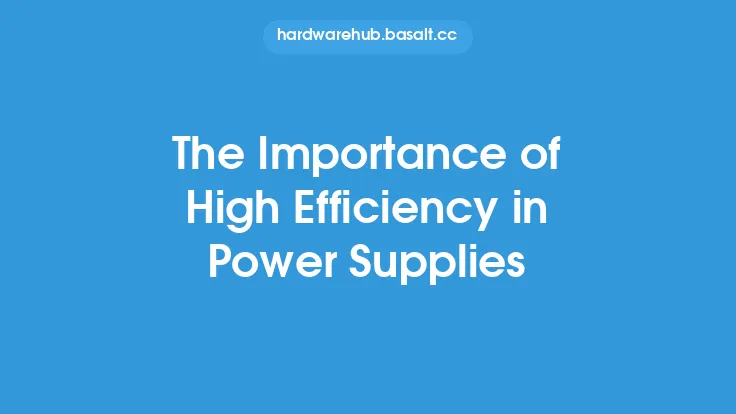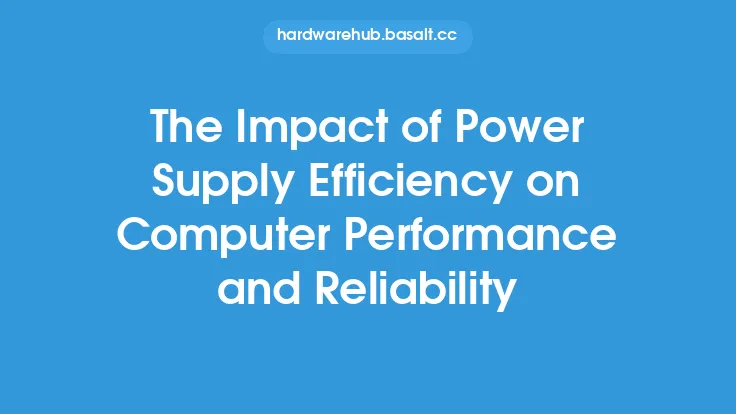High efficiency power supplies have become a crucial component in modern computing, offering numerous benefits for both the environment and budget. The primary function of a power supply is to convert Alternating Current (AC) from the mains to Direct Current (DC) for the computer's components. However, traditional power supplies often waste a significant amount of energy in the form of heat, which not only increases electricity bills but also contributes to environmental pollution. In contrast, high efficiency power supplies are designed to minimize energy waste, providing a more sustainable and cost-effective solution.
Introduction to High Efficiency Power Supplies
High efficiency power supplies are designed to achieve high efficiency ratings, typically 80 PLUS Gold, Platinum, or Titanium, which indicates that they can convert at least 90%, 92%, or 94% of the input AC power to usable DC power. This is achieved through the use of advanced technologies, such as synchronous rectification, active power factor correction, and high-frequency switching. These technologies enable high efficiency power supplies to reduce energy waste, decrease heat generation, and increase overall reliability.
Environmental Benefits
The environmental benefits of high efficiency power supplies are numerous. By reducing energy waste, these power supplies decrease the amount of greenhouse gas emissions produced by power plants, which contribute to climate change. Additionally, high efficiency power supplies require less energy to operate, which reduces the strain on the power grid and helps to conserve natural resources. Furthermore, the reduced heat generation of high efficiency power supplies decreases the risk of overheating, which can lead to premature component failure and electronic waste. According to the US Environmental Protection Agency (EPA), widespread adoption of high efficiency power supplies could prevent millions of tons of carbon dioxide emissions and save billions of dollars in energy costs.
Budget Benefits
The budget benefits of high efficiency power supplies are also significant. By reducing energy waste, these power supplies can help consumers save money on their electricity bills. According to the US Department of Energy, a high efficiency power supply can save a consumer up to $100 per year in energy costs, depending on usage patterns. Additionally, high efficiency power supplies often have a longer lifespan than traditional power supplies, which can reduce maintenance and replacement costs over time. Furthermore, many utility companies offer rebates and incentives for consumers who purchase high efficiency power supplies, which can help offset the initial cost of the device.
Technical Benefits
From a technical perspective, high efficiency power supplies offer several benefits. They typically have a higher power factor, which indicates how effectively the power supply uses the input AC power. A higher power factor reduces the strain on the power grid and decreases the risk of overheating. High efficiency power supplies also often have a lower total harmonic distortion (THD), which indicates the amount of distortion in the output DC power. A lower THD reduces the risk of component failure and increases overall system reliability. Additionally, high efficiency power supplies often have a higher mean time between failures (MTBF), which indicates the average time the power supply is expected to operate before failing. A higher MTBF increases overall system uptime and reduces maintenance costs.
Real-World Applications
High efficiency power supplies have numerous real-world applications. They are commonly used in data centers, where they can help reduce energy costs and increase system reliability. They are also used in gaming computers, where they can help increase system performance and reduce overheating. Additionally, high efficiency power supplies are used in embedded systems, such as set-top boxes and network devices, where they can help reduce energy consumption and increase system reliability. Furthermore, high efficiency power supplies are used in renewable energy systems, such as solar and wind power, where they can help increase system efficiency and reduce energy waste.
Conclusion
In conclusion, high efficiency power supplies offer numerous benefits for both the environment and budget. By reducing energy waste and increasing system reliability, these power supplies can help consumers save money on their electricity bills and reduce their carbon footprint. With their advanced technologies and high efficiency ratings, high efficiency power supplies are an essential component in modern computing. As the demand for sustainable and cost-effective solutions continues to grow, high efficiency power supplies will play an increasingly important role in reducing energy consumption and promoting environmental sustainability.





